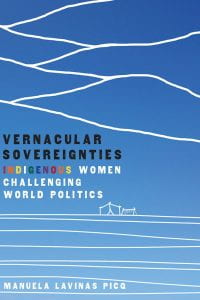A Review of Vernacular Sovereignties
Kichwa Women for a Democracy with Diversity

Vernacular Sovereignties Indigenous Women Challenging World Politics by Manuela Lavinas Picq (Tucson: The University of Arizona Press, 2018, 215 pages.
Manuela Lavinas Picq, a professor at the Universidad San Francisco en Quito, Ecuador, offers a rarely seen representation of Latin American Indigenous women as a collective, historical and political actor in search of justice and social transformation. Eurocentric, capitalist and racist Hispanic structures of Latin American states have been oppressing Indigenous and Afro-descendant peoples in various symbolic and material ways in the last 500 years. Within these structures, women have also suffered oppression by intergroup and intragroup sexism. The various institutionalized forms of their oppression have sought their naturalization in both the dominant and subordinate cultures through the propagation of images of Indigenous and Afro-descendant women as subordinate, exotic or primitive beings clinging to an archaic past.
By denying their status as historical agents, these colonial and neocolonial images have objectified Indigenous and Afro-descendant women despite these women’s long political praxis of voicing their collective subjectivity and exerting social participation. This book’s research centers on the citizen subjectivity dynamics of the Kichwa women of Ecuador.
Reading Picq’s book, I realize that the process of identity construction of Indigenous women is different from the process of Western women described in Le Deuxième Sexe by Simone de Beauvoir. According to Beauvoir, when young Western women discover that the established world (industrial, capitalist and patriarchal society) denies them the full realization of their freedom, many choose to evade that world in various ways. Some of the most frequent options are immersion in the fantasies of romantic love or in those offered by the arts and cultural industries. Of course, the feminists opt for rebellion. Beauvoir’s proposed process of identity development for Western women could perhaps be applied to Latin American women of urban, upper middle class, and more European heritage; however, it is not applicable to the women protagonists of Picq’s book.
That is because the condition of being an Indigenous woman in Latin America is distinctively different and, thus, their experiences and trajectories of their identity formation are too. From the case of Kichwa women’s participation in the constitutional reform of Ecuador, Picq shows us women experiences that have developed a logic and historical-political dynamic of affirmation as collective agents with a desire for transformation, despite the structural marginalization of their world.
However, Indigenous women’s role as dynamic actors has been systematically negated within the dominant national culture, one which is still pervasively patriarchal, Eurocentric, racist and exploitative. I suggest that, in some way, Indigenous women represent the anti-thesis of national identity promoted by Latin American states. Thus, feminine indigeneity can be said to coexist dialectically with masculine Hispanicity. For me, Picq’s research reveals crucial political aspects of this dialectical tension between the patriarchal sectors of the State and the female sectors of Indigenous citizenship in Ecuador.
Picq maintains that the activism of the Kichwa women has redefined the authority of the Ecuadorian state making use of its own legal systems, as well as the national and international legal systems. From this case, she draws comparisons with other scenarios such as Latin American and Anglo-American, colonial and republican, to show the similarities regarding the logic and dynamics of the historical-political action of Indigenous women in the face of tyrannical power structures. She calls the corpus of legal authority constituted through this struggle for socio-cultural-political recognition “vernacular sovereignties”.
In chapter 1 Invisible Women, the author offers a description of the situation of Indigenous women in Ecuador making comparisons with the situation of Indigenous women in other countries of the Americas (which are called Abya Yala by Indigenous peoples) and other continents. I think that the structural situation of Indigenous women in all these countries reflects what the philosopher Iris Marion Young called the “Five Faces of Oppression” in a democratic society: exploitation, marginalization, disempowerness, cultural imperialism and violence. These indicators can be found across the Americas.
Chapter 2, The inheritance of resistance, details Ecuadorian Indigenous women’s past and continued fight for their right to justice at the local, national and international levels. In the face of an oppressive system that tries to disempower them daily, these women collectively gather strength to empower themselves, showing an admirable historical resilience.
Picq’s presentation of Dolores Cacuango (1881-1971) and Tránsito Amaguaña (1909-2009), two of the most emblematic Ecuadorian Indigenous leaders, is worth noting:
She was an illiterate Indigenous woman who debated with Congress, met with Ecuador’s president, and advocated for workers’ equality in rural and urban areas from Bogotá to Guayaquil. She spoke passionately –captivating large crowds and bringing together mestizos and Indigenous peoples in eloquent discourses … two core issues characterize her activism: redistribution of land ownership and bilingual education (p. 73).
Amaguaña gave international scope to Ecuador’s Indigenous movement. She boldly voiced Indigenous indignation and collective demands from the National Congress in Quito to Political Forums in Europe … she traveled first through Ecuador to organize Indigenous demands for agrarian reform, then undertook international efforts to support broader workers’ struggles (p. 75).
Next, the author discusses one of the contradictions that affect many of the Indigenous movements in the Americas, the intragroup reproduction of gender inequalities. Once the movements become institutionalized, women are pushed aside, forcing them to wage two simultaneous battles: one within their own culture and the other against the dominant state culture.
Chapter 3, Indigenous International Relations, shows us that, although indigeneity is constitutive of colonial states organized according to international legislation derived from the Westphalia Agreement (1648), Indigenous women have confronted and transformed the international legal system in order to obtain autonomy within their own national states. These actions of Indigenous women have confronted the prejudices that seek to confine them to strictly local knowledge. Thus the policy of each Latin American state towards its Indigenous people is influenced by international Indigenous networks, within which women have a relevant role. In this way, indigeneity, a once instrumental concept for coloniality of power, taken by the ancestral peoples of Abya-Yala becomes an instrument for liberation.
In these struggles, as chapters 4 (Self-Determination with Gender Parity) and 5 (Sovereignties Within) expose, the Ecuadorian Kichwa women have cleverly triangulated three legal systems: Indigenous, national and international. Chapter 4 offers a quasi-ethnographic case study of the activism of the Chimborazo Kichwa women’s network to change Ecuador’s Constitution in 2008. They managed to add several articles to guarantee the participation of women in all decisions related to the exercise of collective rights, and among other areas, within the Indigenous justice administration. This was the first time in the world that a justice system respected gender parity norms. An achievement which has been made invisible by racism and dominant machismo. Picq examines how this legal regulation allows us to conceive a differentiated democracy. In addition, she argues that in this case, Indigenous culture and feminism are reconciled.
Chapter 5 specifies the central thesis of this book: that Indigenous women use three legal systems, Indigenous justice, national Constitution and international norms, to strengthen the authority of Indigenous justice. Alternatively, the limitations of one system have been overcome with the possibilities of another to build legal tools that can expand the guarantees of rights necessary for an autonomous life. Consequently, these women are consolidating the self-determination of Indigenous peoples by holding them accountable to international human rights as if they were states. Picq calls this increase in self-determination within the sovereignty of the national state ‘vernacular sovereignties’. For her, it is a process similar to that of the European Union, but instead of transferring legal sovereignty to the supranational level of the Union, it is being transferred to Indigenous communities.
Picq thematizes the West’s misunderstanding of Indigenous political authority systems as part of the cultural disagreement between the European world and that of Abya Yala. For her, Indigenous sovereignties cannot be understood from the European parameters of the nation-state. By putting their beliefs first, the Spanish colonizers became incapable of understanding the Andean political world. A similar mistake is the one made by the current Latin American states. The current conception of state sovereignty aims to perpetuate the false dichotomy between political modernity and Indigenous ancestry. The Indigenous is not only defined as the other, but is placed within the past. This prevents seeing Indigenous citizenships as “urban and cosmopolitan, as political actors of the international system” whose dynamics support current political reality.
Indigenous political visions offer an opportunity to think about international politics beyond the centralist state parameters established by the treaty of Westphalia. This research developed by Picq reveals, not only invisible struggles, but also the abundant similarities in the national and international proposals and strategies employed by Indigenous women for their vernacular sovereignty within their respective nation states. Picq’s work has assumed the need to overcome Western’s historical misunderstanding of Indigenous political traditions and to seek ways for dignified coexistence between these societies. I believe this misunderstanding derives from the epistemological difference behind the Western (anthropocentric and individualistic) and the Indigenous (biocentric and collectivistic) worldview, which is also expressed in the different economic, scientific, artistic and social knowledge and practices of both worlds. As Picq’s research suggests, addressing the epistemological dimension will be key to building a fair coexistence between Indigenous and Western civilization. Her book invites us to reassess the decolonial contributions of Indigenous women and to rethink Latin American sovereignties in a period of deepening dysfunctionality and crisis of legitimacy within Latin American states.
Reseña de Vernacular Sovereignties
Mujeres kichwa por una democracia con diversidad
Por Luis Martín Valdiviezo Arista

Vernacular Sovereignties Indigenous Women Challenging World Politics by Manuela Lavinas Picq (Tucson: The University of Arizona Press, 2018, 215 pages.
Manuela Lavinas Picq, profesora en la Universidad San Francisco en Quito, Ecuador, ofrece una representación pocas veces vista de la mujer indígena latinoamericana como sujeto colectivo, histórico y político en busca de justicia y transformación social. Es sabido que las estructuras hispanas eurocéntricas, capitalistas y racistas de los Estados latinoamericanos han oprimido de diversas maneras simbólicas y materiales a los pueblos indígenas y afrodescendientes en los últimos 500 años. Dentro de ellos, las mujeres, además, se han visto oprimidas por el machismo intergrupal e intragrupal.
Las diversas formas institucionalizadas de su opresión han buscado su naturalización tanto en la cultura dominante como en las subordinadas a través de la propagación de imágenes de la mujer indígena y de la mujer afrodescendiente como seres subalternos, exóticos, primitivos o aferrados a un pasado arcaico. Estas imágenes coloniales y neocoloniales han objetivado a estas mujeres; es decir, les han negado su condición de sujetos históricos, a pesar de que ellas han expresado su subjetividad colectiva y su participación social a través de una larga praxis política. Las dinámicas de esta subjetividad ciudadana en las mujeres kichwas del Ecuador son el centro de esta investigación.
De alguna manera, el proceso de formación de la mujer indígena es distinto al de la mujer occidental descrito en Le deuxième sexe por Simone de Beauvoir. Según de Beauvoir, cuando las mujeres occidentales jóvenes descubren que el mundo establecido (sociedad industrial, capitalista y patriarcal) niega la realización plena de su libertad, muchas optan por evadir ese mundo de diversas formas. Algunas de las más frecuentes opciones son la sumersión en las fantasías del amor romántico, o en las que ofrecen las artes e industrias culturales. Por supuesto, las feministas optan por la rebelión. Esta es una descripción que también podría aplicarse a las mujeres de clase media alta, urbanas y de identidades más europeas en América Latina.
La condición de las mujeres indígenas es distinta y, por ello, son distintas sus experiencias. A partir del caso de la participación de las mujeres kichwas en la reforma constitucional del Ecuador, Picq nos muestra una experiencia de feminidad que ha desarrollado una lógica y dinámica histórico-política de afirmación como sujetos colectivos con voluntad de transformación a pesar de la marginación estructural de su mundo.
Sin embargo, este rol como sujeto de la mujer indígena ha sido sistemáticamente negado desde una cultura nacional dominante patriarcal, eurocéntrica, racista y explotadora. Sugiero que, de alguna manera, la mujer indígena representa la anti-tesis de la identidad nacional promovida por los Estados latinoamericanos. Entre la tesis de la hispanidad masculina y su anti-tesis, la indigenidad femenina puede darse una relación dialéctica. De alguna manera, esta investigación revela aspectos políticos cruciales de esta tensión dialéctica entre los sectores patriarcales del Estado y los sectores femeninos de la ciudadanía indígena en el Ecuador.
Picq sostiene que el activismo de la mujer kichwa ha redefinido la autoridad del Estado ecuatoriano haciendo uso de sistemas legales propios, así como del sistema legal nacional e internacional. A partir de este caso, ella desarrolla comparaciones con otros escenarios, latinoamericanos y angloamericanos, coloniales y republicanos, para mostrar las similitudes en cuanto a la lógica y dinámicas del accionar histórico-político de las mujeres indígenas frente a estructuras de poder adversas. Ella denomina “vernacular sovereignties” al corpus de autoridad legal constituido a través de esta lucha por el reconocimiento socio-cultural-político.
En el capítulo 1, Invisible Women, la autora ofrece una descripción de la situación de las mujeres indígenas ecuatorianas haciendo comparaciones puntuales con la situación de otras mujeres indígenas en Abya Yala (América) y otros continentes. En mi opinión, la situación estructural mayoritaria de las mujeres indígenas del continente refleja lo que la filósofa Iris Marion Young llamó the Five Faces of Oppression en una sociedad democrática: exploitation, marginalization, desempowerness, cultural imperialism y violence. Es posible encontrar estos indicadores en todos los países. Como lo expone Picq en el Capítulo 2, The inheritance of Resistance, las organizaciones de mujeres indígenas ecuatorianas han luchado y luchan a nivel local, nacional e internacional por su derecho a la justicia. A pesar de que el sistema ha intentado desempoderarlas, ellas se han auto-empoderado repetidamente mostrando una resiliencia histórica admirable.
Es de destacar, la presentación que hace Picq de Dolores Cacuango (1881-1971) y Tránsito Amaguaña (1909-2009) dos de las más emblemáticas lideresas indígenas ecuatorianas:
She was an illiterate Indigenous women who debated with Congress, met with Ecuador’s president, and advocate for workers’ equality in rural and urban areas from Bogotá to Guayaquil. She spoke passionately –captivating large crowds and bringing together mestizos and Indigenous peoples in eloquent discourses … two core issues characterize her activism: redistribution of land ownership and bilingual education (p. 73)
Amaguaña gave international scope to Ecuador’s Indigenous movement. She boldly voiced Indigenous indignation and collective demands from the National Congress in Quito to Political Forums in Europe … she traveled first through Ecuador to organize Indigenous demands for agrarian reform, then undertook international efforts to support broader workers’ struggles (p. 75)
Además, aquí la autora discute una de las contradicciones que afectan a muchos de los movimientos indígenas en las Américas: la reproducción intragrupal de las desigualdades de género. Una vez que los movimientos se institucionalizan, las mujeres son puestas a un lado, lo que obliga a las mujeres a librar dos batallas simultáneas: una dentro de su propia cultura y, otra, frente a la cultura estatal dominante.
En el capítulo 3, Indigenous International Relations, nos muestra que, aunque la indigenidad es constitutiva de los Estados coloniales organizados según una legislación internacional derivada del Acuerdo de Westfalia (1648), las mujeres indígenas han confrontado y transformado el sistema legal internacional a fin de obtener autonomía dentro de sus propios Estados nacionales. Estas acciones de las mujeres indígenas han confrontado los prejuicios que pretenden confinarlas a un saber estrictamente local. Así, la política de cada Estado latinoamericano frente a los pueblos indígenas es influenciada por las redes indígenas internacionales, dentro de las cuales las mujeres tienen un rol relevante. De alguna manera, la indigenidad, un concepto instrumental para la colonialidad del poder, tomado por los pueblos ancestrales de Abya-Yala, se convierte en un instrumento para luchar por la liberación.
En estas luchas como exponen los capítulos 4 (Self-Determination with Gender Parity) y 5 (Sovereignties Within), la mujer Kichwa ecuatoriana ha triangulado con sagacidad tres sistemas legales: el indígena, el nacional y el internacional. El capítulo 4 ofrece un estudio de caso casi etnográfico sobre el activismo de la red de mujeres kichwas de Chimborazo para cambiar la Constitución de Ecuador el 2008. Ellas lograron añadir varios artículos para garantizar la participación de las mujeres en todas las decisiones relativas al ejercicio de los derechos colectivos; entre otros ámbitos, dentro de la administración de justicia indígena. Esta fue la primera vez en el mundo que un sistema de justicia respetó normas de paridad de género. Un logro invisibilizado por el racismo y el machismo dominante. Picq examina como esta normativa jurídica permite concebir una democracia diferenciada. Además, argumenta que en este caso se reconcilian la cultura indígena y el feminismo.
En el capítulo 5 se detalla la tesis central del libro: las mujeres indígenas utilizan tres sistemas legales (justicia indígena, Constitución nacional y normas internacionales) para fortalecer la autoridad de la justicia indígena. Alternativamente, las limitaciones de un sistema han sido superadas con las posibilidades de otro hasta construir herramientas legales para ampliar las garantías del conjunto de derechos necesarios para una vida autónoma. Así, ellas están consolidando la libre determinación de los pueblos indígenas haciendo que estos rindan cuenta por los derechos humanos internacionales como si fueran Estados. Picq denomina “soberanías vernaculares” a este aumento de libre determinación dentro de la soberanía del Estado nacional. Para ella, es un proceso similar al de la Unión Europea, pero en vez de trasladar la soberanía jurídica al nivel supranacional de la Unión, se está trasladando a las comunidades indígenas.
Picq tematiza la incomprensión de los sistemas de autoridad política indígena por parte de Occidente como parte del desencuentro cultural entre el mundo europeo y el de Abya Yala. Para ella, las soberanías indígenas no pueden entenderse desde los parámetros europeos del Estado-nación. Al anteponer sus creencias, los colonizadores españoles se incapacitaron para entender el mundo político andino. Un error similar es el que cometen los actuales Estados latinoamericanos. La concepción actual de soberanía del Estado pretende perpetuar la falsa dicotomía entre una modernidad política y una ancestralidad indígena. Lo indígena no es solo definido como lo otro, sino que es colocado dentro del pasado. Esto impide ver a las ciudadanías indígenas como “urban and cosmopolitan, as political actors of the international system” cuyas dinámicas sostienen la realidad política actual.
Las visiones políticas indígenas ofrecen una oportunidad de pensar la política internacional más allá de los parámetros estatales centralistas establecidos por el tratado de Wesfalia. Esta investigación de Picq nos revela no solo luchas invisibilizadas sino también las abundantes similitudes en las propuestas y estrategias nacionales e internacionales empleadas por las mujeres indígenas en pro de su soberanía vernacular dentro de sus respectivos Estados nacionales. El trabajo de Picq ha asumido la necesidad de superar la incomprensión occidental de las tradiciones políticas indígenas y de buscar formas de convivencia digna entre estos mundos. Creo que esta incomprensión se deriva de la diferencia epistemológica detrás de la cosmovisión occidental (antropocéntrica e individualista) y la indígena (biocéntrica y comunitaria), y se expresa también en los diversos saberes y prácticas económicas, científicas, artísticas y sociales de ambos mundos. Como la investigación de Picq sugiere, abordar lo epistemológico será clave para construir una convivencia justa entre la civilización indígena y la occidental. De alguna manera, esta investigación nos invita a revalorar los aportes decoloniales de las mujeres indígenas para repensar las soberanías latinoamericanas en un periodo de ahondamiento de la disfuncionalidad y de crisis de legitimidad de los Estados latinoamericanos.
Spring/Summer 2020, Volume XIX, Number 3
Luis Martin Valdiviezo Arista, the 2020-2021 DRCLAS Custer Visiting Scholar, is a Peruvian of African, Indigenous, and Hispanic descent. His research explores the intersections of ethnicity, gender, social class, and formal education in the functioning of the Peruvian society. His most recent book is (Auto)Reconocimiento de la afroperuanidad en la educación peruana, 2018. He had written three novels and two dozen short stories.
Investigador Visitante Custer 2020-2021 del DRCLAS, Luis Martín Valdiviezo Arista es un peruano con raíces africanas, indígenas e hispanas. Sus investigaciones exploran las intersecciones entre etnicidad, género, clase social y educación formal en el funcionamiento de la sociedad peruana . Su más reciente libro es (Auto)Reconocimiento de la afroperuanidad en la educación peruana en el 2018. Además, ha escrito tres novelas y dos docenas de cuentos.
Related Articles
A Review of San Fernando: Última Parada, Viaje al crimen autorizado en Tamaulipas
One of Mexico’s best investigative journalists, Marcela Turati, takes readers to terrorized and traumatized San Fernando, a town known for dozens of mass graves, and exposes the depths of criminal brutality and official corruption that hid the bodies and the truth for years.
A Review of Until I Find You: Disappeared Children and Coercive Adoptions in Guatemala
A student in my “Introduction to Cultural Anthropology” course at the University of Delaware approached me several weeks ago, after hearing about my long-term research in Guatemalan communities, to tell me that they were born there, in Guatemala.
A Review of Default: The Landmark Court Battle over Argentina’s $100 Billion Debt Restructuring
In February 2019, I found myself serving as the special attorney general for the then newly recognized interim government of Venezuela, tasked with addressing more than 50 claims before the U.S. courts stemming from the $140 billion debt inherited from Hugo Chávez and Nicolás Maduro.




